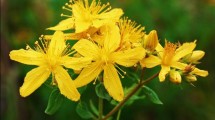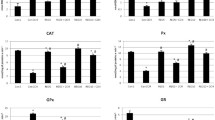Abstract
Reserpine, a bioactive compound isolated from the roots of Rauwolfia serpentine, is known to deplete dopamine, a neurotransmitter. The clinical application of reserpine has been associated to manage hypertension, insanity, insomnia and schizophrenia. However, the usage of reserpine as a drug is restricted because of its ability of inducing excess free radicals production and oxidative stress resulting into damage to liver and other organs. Here, we have explored the antioxidative potential of extract of garlic prepared using ethanol (EEG) against reserpine-induced hepatic damage in the albino Wister rats.The animals were divided into four different groups containing 6 animals in each: (1) control + placebo, (2) control + EEG, (3) reserpine and (4) reserpine with EEG. The reserpine treatment resulted into sharp increase in the level of MDA and significant reduction in the activitiesof key antioxidative enzymes (SOD, GST, and CAT) in the rat liver. It also caused sharp perturbations in the levels of certain hepatic transaminases (ALT, AST) and glycolytic LDH. The histopathological results revealed hepatic necrosis, which could have occurred due to reserpine induced lipid peroxidation as well as reduction in the levels of antioxidant species.The administration of EEG, however, significantly ameliorated reserpine induced hepatotoxicity. These results reflected the ameliorative property of EEG, which was probably mediated via its antioxidant function as it contains several bioactive molecules with free radical quenching potential.This study suggestedthe prospective application of EEG as a supplement to combat the side effects of reserpine.



Similar content being viewed by others
References
Boy HI, Rutilla AJ, Santos KA, Ty AM, Alicia IY, Mahboob T, Tangpoong J, Nissapatorn V. Recommended medicinal plants as source of natural products: a review. Dig Chin Med. 2018;1(2):131–42.
Palombo EA. Traditional medicinal plant extracts and natural products with activity against oral bacteria: potential application in the prevention and treatment of oral diseases. Evid-Based Comp Altern Med. 2011;2011:1–15.
Wimalasena K. Vesicular monoamine transporters: structure-function, pharmacology, and medicinal chemistry. Med Res Rev. 2011;31(4):483–519.
Abboud FM, Eckstein JW, Lawrence MS, Hoak JC. Preliminary observations on use of intra-arterial reserpine in raynauds phenomenon. In Circulation. 1967;36(4):49–52.
Balzer H, Makinose M, Hasselbach W. The inhibition of the sarcoplasmic calcium pump by prenylamine, reserpine, chlorpromazine and imipramine. Naunyn-SchmiedebergsArchiv für Pharmakologie und Experimentelle Pathologie. 1968;260(5):444–55.
LiverTox: Clinical and Research Information on Drug-Induced Liver Injury [Internet]. Bethesda (MD): National Institute of Diabetes and Digestive and Kidney Diseases; 2012. Reserpine. [Updated 2018 May 21]. Available from: https://www.ncbi.nlm.nih.gov/books/NBK548348/.
Yi R, Wang R, Sun P, Zhao X. Antioxidant-mediated preventative effect of dragon-pearl tea crude polyphenol extract on reserpine-induced gastric ulcers. Exp Ther Med. 2015;10(1):338–44.
Sharifi-Rad M, Anil Kumar NV, Zucca P, Varoni EM, Dini L, Panzarini E, Rajkovic J, TsouhFokou PV, Azzini E, Peluso I, Prakash MA. Lifestyle, oxidative stress, and antioxidants: back and forth in the pathophysiology of chronic diseases. Front Physiol. 2020;11:694.
Bilici M, Efe H, Köroğlu MA, Uydu HA, Bekaroğlu M, Değer O. Antioxidative enzyme activities and lipid peroxidation in major depression: alterations by antidepressant treatments. J Affect Disord. 2001;64(1):43–51.
Eren I, Nazıroğlu M, Demirdaş A, Çelik Ö, Uğuz AC, Altunbaşak A, Özmen İ, Uz E. Venlafaxine modulates depression-induced oxidative stress in brain and medulla of rat. Neurochem Res. 2007;32(3):497–505.
Khushboo SB, Sharma B. Antidepressants: mechanism of action, toxicity and possible amelioration. J Appl Biotechnol Bioeng. 2017;3(5):437.
Samarghandian S, Azimi-Nezhad M, Borji A, Samini M, Farkhondeh T. Protective effects of carnosol against oxidative stress induced brain damage by chronic stress in rats. BMC Complement Altern Med. 2017;17(1):1–7.
Ushijima M, Sumioka I, Kakimoto M, Yokoyama K, Uda N, Matsuura H, Kyo E, Suzuki A, Kasuga S, Itakura Y, Petesch BL. Effect of garlic and garlic preparations on physiological and psychological stress in mice. Phytother Res. 1997;11(3):226–30.
Chauhan NB, Sandoval J. Amelioration of early cognitive deficits by aged garlic extract in Alzheimer’s transgenic mice. Phytother Res. 2007;21(7):629–40.
Yamaguchi Y, Kumagai H. Characteristics, biosynthesis, decomposition, metabolism and functions of the garlic odour precursor. S-allyl-L-cysteine sulf Exp Ther Med. 2020;19(2):1528–35.
Reuter HD, Koch HP, Lawson D. Therapeutic effects and applications of garlic and its preparations. In: Lawson LD, Koch HP, editors. Garlic: The science and therapeutic applications of Allium sativum L. and related species. 2nd ed. Baltimore: William & Wilkins; 1996. p. 135–212.
Niehaus WG Jr, Samuelsson B. Formation of malonaldehyde from phospholipid arachidonate during microsomal lipid peroxidation. Eur J Biochem. 1968;6(1):126–30.
Sedlak J, Lindsay RH. Estimation of total, protein-bound, and nonprotein sulfhydryl groups in tissue with Ellman’s reagent. Anal Biochem. 1968;25:192–205.
Marklund S, Marklund G. Involvement of the superoxide anion radical in the autoxidation of pyrogallol and a convenient assay for superoxide dismutase. Eur J Biochem. 1974;47(3):469–74.
Beers RF, Sizer IW. A spectrophotometric method for measuring the breakdown of hydrogen peroxide by catalase. J Biol chem. 1952;195(1):133–40.
Horecker BL, Kornberg A. The extinction coefficients of the reduced band of pyridine nucleotides. J Biol Chem. 1948;175(1):385–90.
Lowry O, Rosebrough N, Farr AL, Randall R. Protein measurement with the Folin phenol reagent. J Biol Chem. 1951;193(1):265–75.
Halaris AE, Freedman DX. Loss of body weight as a predictor of reserpine-induced amine depletion. Eur J Pharmacol. 1975;32(1):93–101.
Gorka Z, Adamik P. The effect of reserpine and stress on feeding behaviour in the light and dark phases of the diurnal cycle in rats. J Pharm Pharmacol. 1993;45(2):137–8.
Prange AJ, Bakewell WE. Effects of imipramine and reserpine on body size and organ size in euthyroid and hyperthyroid growing rats. J Pharmacol Exp Ther. 1966;151(3):409–12.
Dhingra D, Gahalain N. Reversal of reserpine-induced orofacial dyskinesia by chlorogenic acid in rats. Pharmacol. 2016;7(5):272–7.
Burger M, Fachinetto R, Calegari L, Paixão MW, Braga AL, Rocha JB. Effects of age on reserpine-induced orofacial dyskinesia and possible protection of diphenyl diselenide. Brain Res Bull. 2004;64(4):339–45.
Naidu PS, Singh A, Kulkarni SK. Effect of Withania somnifera root extract on reserpine-induced orofacial dyskinesia and cognitive dysfunction. Phytother Res. 2006;20(2):140–6.
Al-Bloushi S, Safer AM, Afzal M, Mousa SA. Green tea modulates reserpine toxicity in animal models. J Tox Sci. 2009;34(1):77–87.
Vaváková M, Ďuračková Z, Trebatická J. Markers of oxidative stress and neuroprogression in depression disorder. Oxid Med Cell Longev. 2015;2015:1–12.
McCloskey MC, Young TJ, Anderson SM. The influences of acetylcholinesterase on anxiety-and depression-like behaviors in fluoxetine-treated male mice. Bios. 2017;88(1):29–38.
Younes M, Siegers CP. Lipid peroxidation as a consequence of glutathione depletion in rat and mouse liver. Res Commun Biochem Cell Mol Biol. 1980;27(1):119–28.
Wolf DC, Carlson GP, DeNicola DB, Carlton WW. Effects of reserpine and L-cysteine and glutathione depletion on 2-bromoethylamine hydrobromide-induced tubular necrosis in Swiss ICR mice. Food Chem Toxicol. 1991;29(8):565–73.
Nade VS, Dwivedi S, Kawale LA, Upasani CD, Yadav AV. Effect of Hibiscus rosa sinensis on reserpine-induced neurobehavioral and biochemical alterations in rats. IJEB. 2009;46(07):559–63.
Bradham CA, Plümpe J, Manns MP, Brenner DA, Trautwein CI. TNF-induced liver injury. Am J Physiol Gastrointest Liver Physiol. 1998;275(3):387–92.
Ahmed NA, Radwan NM, Al-Zahaby AS, Abd El-Salam MM. Reserpine effects on neurotransmitters in chick heart during growth. J Physiol Paris. 1997;91(2):81–90.
Bardon A, Müller RM, Ceder O, Roomans GM. The chronically reserpinized rat: decreased glycolytic activity in the submandibular gland. Biochem Med. 1985;33(1):99–103.
Crivellato E, Belloni A, Nico B, Nussdorfer GG, Ribatti D. In vivo administered reserpine increases piecemeal degranulation in rat adrenal chromaffin cells. Anat Rec. 2006;288(3):286–91.
Rose P, Whiteman M, Moore PK, Zhu YZ. Bioactive S-alk (en) yl cysteine sulfoxide metabolites in the genus Allium: the chemistry of potential therapeutic agents. Nat Prod Rep. 2005;22(3):351–68.
Shin JH, Choi DJ, Chung MJ, Kang MJ, Sung NJ. Changes of physicochemical components and antioxidant activity of aged garlic at different temperatures. J Korean Soc Food Sci Nutr. 2008;37(9):1174–81.
Kim JS, Kang OJ, Gweon OC. Comparison of phenolic acids and flavonoids in black garlic at different thermal processing steps. J Funct Foods. 2013;5(1):80–6.
Jang HJ, Lee HJ, Yoon DK, Ji DS, Kim JH, Lee CH. Antioxidant and antimicrobial activities of fresh garlic and aged garlic by-products extracted with different solvents. Food Sci Biotechnol. 2018;27(1):219–25.
Amagase H, Petesch BL, Matsuura H, Kasuga S, Itakura Y. Intake of garlic and its bioactive components. J Nutr. 2001;131(3):955–62.
Park BK, Kim YR, Kim YH, Yang C, Seo CS, Jung IC, Jang IS, Kim SH, Lee MY. Antidepressant-like effects of gyejibokryeong-hwan in a mouse model of reserpine-induced depression. BioMed Res Int. 2018;2018:1–12.
Khushboo Kumar A, Sharma B. Biomedical implications of plant-based principles as antidepressants: prospects for novel drug development. Mini Rev Med Chem. 2021. https://doi.org/10.2174/1389557521666210415112601 (Online ahead of print).
Khushboo, Kumar A, Sharma B. Phytochemicals as antidepressants. In: Patra JK, Shukla AC, Das G, editors. Advances in pharmaceutical biotechnology. Singapore: Springer; 2020. p. 115–31.
Acknowledgements
Khushboo is thankful to UGC-New Delhi for financial support in the form of a research fellowship. Authors acknowledge UGC-SAP and DST-FIST for providing research facilities to conduct the present work. BS is grateful to UPCST-Lucknow for financial support in the form of a Research Grant.
Author information
Authors and Affiliations
Corresponding author
Ethics declarations
Conflict of Interests
Authors declare that they do not have any conflict of interests.
Consent for Publication
All the authors extend their consents for publication of this manuscript.
Consent to Participate
All the authors have participated in preparation of the manuscript.
Ethical Approval
Ethical approval was accorded by the Institutional Animal Ethical Committee at University of Allahabad.
Informed Consent
Not applicable.
Research Involving Human Participants and/or Animals
Wistarrats.
Additional information
Publisher's Note
Springer Nature remains neutral with regard to jurisdictional claims in published maps and institutional affiliations.
Rights and permissions
About this article
Cite this article
Khushboo, Gupta, V.K. & Sharma, B. Hepatoprotective Effect of Ethanolic Extract of Garlic Against Reserpine Induced Toxicity in Wistar Rats. Ind J Clin Biochem 38, 251–261 (2023). https://doi.org/10.1007/s12291-022-01045-9
Received:
Accepted:
Published:
Issue Date:
DOI: https://doi.org/10.1007/s12291-022-01045-9




